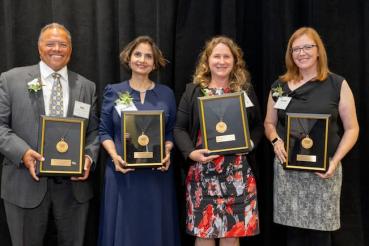More than 350,000 cardiac arrests happen outside the hospital each year in the United States. In most situations, even the most basic knowledge of CPR saves lives. And yet, only 40% of people get that help before paramedics arrive.
A group of medical students at RUSH is working to change that.
How to save a life
RUSH 9-1-1 is dedicated to teaching lifesaving skills to people of all ages in Chicago. First-year medical students teach the two-hour crash course, with demonstrations and hands-on exercises to perform CPR, use a heart defibrillator, stop bleeding or treat an overdose with Narcan.
The group was created in 2022 by third-year RUSH Medical College students Sam Shuman and Brian Goldberg. Recognizing the need for this training, they wanted to find a way to not only teach these skills but make them easier to access.
“CPR and first aid certification classes commonly taught across the country aren’t that accessible,” Shuman says. “A typical CPR certification course on average costs between $40 to $50, they’re taught in English, and they’re typically held in centralized locations. All these factors create significant barriers to education that we strongly believe everyone should have in the first place.”
RUSH 9-1-1 gets around those barriers. The course is free, and classes can be held at any location. Instructors will pack up and travel to teach the course wherever it’s requested in Chicago, prioritizing West Side and South Side communities that are disproportionately impacted by gun violence and the opioid epidemic.
Practice doesn’t have to make perfect
Bystander CPR can be pivotal in prolonging someone’s life before they can be treated by medical professionals, but disparities exist in who gets this crucial care. A recent study showed Black and Hispanic people were less likely to receive bystander CPR at home and in public locations when compared to white people. By increasing access to opportunities to learn CPR in Chicago’s Black and Hispanic communities, the group hopes it can help narrow that gap.
“These are the folks who are on the ‘front lines,’” says Stephen Baldassari, a rising second-year medical student who teaches RUSH 9-1-1. “We always talk about first responders being medical professionals, but really the people who are already there are the immediate responders. They’re there before the ambulance, and it can make a big difference.”
Being responsible for delivering lifesaving care can be intimidating, and the pressure to get it right can be overwhelming. But practice doesn’t need to make perfect.
“We’re not expecting folks to be paramedics after a two-hour course,” Goldberg says. “Doing something is way better than doing nothing, even if it’s not perfect. The point is that when they call 911, the dispatcher on the phone telling them where to place their hands for CPR won’t be the first time they’re going to hear it.”
The end goal for people taking a RUSH 9-1-1 course isn’t certification: It’s peace of mind and familiarity. Shuman and Goldberg say they want people to leave feeling empowered to use the skills they learn, since they are the help until help arrives.
“People get really hung up on the certifications,” Goldberg says. “When you call 911, they’re going to want you to do CPR whether or not you’re the world’s foremost physician or cardiologist, or if you’re some guy in the street who watched an episode of ‘Grey’s Anatomy’ once.”
Tailor-made for Chicago
Faculty advisor Nicholas Cozzi, MD, says the club is seeing an increase in demand, partly driven by the surge in opiate overdoses and gun violence in Chicago and across the country.
“Tragically, more people are going to be witnesses to gun violence in our cities and our country,” says Cozzi, an emergency medicine physician, “so the ability to have hemorrhages control and stopping the bleed is going to be essential.”
The group’s curriculum can be tailored to the needs of any specific community in Chicago. If a particular ZIP code has experienced more overdose events, the training session can be adjusted to prioritize Narcan training, overdose prevention and harm reduction over other skills.
Now that Narcan is available over the counter, Cozzi hopes more people will learn how to use it.
“Not a shift goes by where myself or my colleagues in the ER at RUSH don’t see someone suffering from an opiate overdose,” he says. “We’re constantly trying to reduce harm with interventions like Narcan accessibility.”
Saving lives for many years to come
The community is starting to take notice, with demand for the courses starting to grow. RUSH 9-1-1 has received a dozen requests for classes from groups ranging from local coffee shops and youth programs to real estate agents in the days following a recent feature in Block Club Chicago.
It’s a promising sign for the students who started it all.
“I would love to come back in 10 years and see RUSH 9-1-1- going even stronger – with more funding, more people, more classes,” Goldberg says. “That would be an amazing legacy.”
Those who are interested in requesting a class from RUSH 9-1-1 should email Kira Palazzo (kira_l_palazzo@rush.edu). Please include the desired date for the workshop, topics you’d like to have covered, the number of participants and the desired location.




